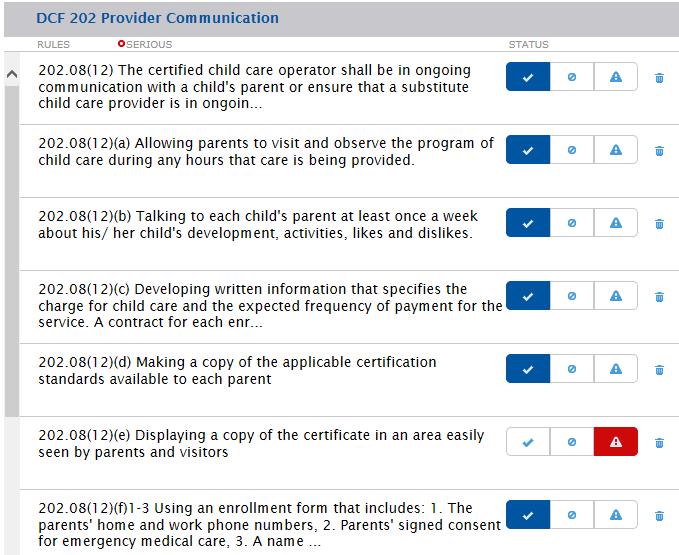

Wisconsin Department of Children and Families - Division of Early Care and Education
Bureau of Early Care Regulation
Child Care Certification Policy Manual
When a violation is observed either through a monitoring visit, complaint investigation or through a file review, the violations shall be promptly entered into WISCCRS. See section 9.1 for additional guidance about when to cite violations and the Certification SharePoint site for further instructions / guidance on when to cite a violation and issue a Noncompliance Statement.
See WISCCRS User Guide –Monitoring Results for instructions on entering violations in WISCCRS. The new Monitoring Results link enables certification workers to easily document/enter multiple violations (as well as rules met) at one time. However, if a certification worker wishes to enter monitoring results (violations and rules met) one at a time, they can use the “New Monitoring Results (Classic View)” link. This link takes user to the WISCCRS screens used prior to 1/20/15 to document violations.
| Monitoring Results
(Can enter monitoring
results of several rules at one time)
|
Classic
View (Requires
entering monitoring results one rule at a time)
 |
Regardless of how the worker documents rules monitored (met and unmet) in WISCCRS, the certifier shall use the Non-Compliance Statement and Correction Plan to cite violations of certification standards (except for initial/relocation visits).
Each violation must correspond to an administrative rule. There are some general rules for each type of program. These general rules can usually be cited for violations where there isn’t a specific rule that addresses the situation. As an example, there is no specific certification rule that requires electrical outlet guards/protectors, but a certification worker would cite a violation under the hazards rule 202.08(2)(c) and possibly include the definition of hazard, and describe the rule violation. Sometimes a state statute (or law) will be enacted or modified before a corresponding administrative rule can be added or changed. A recent example was the Vehicle Alarm Bill. The law was implemented in August 2009, but not incorporated into the administrative certification rule until 2016. If the certification worker observes a rule violation in a circumstance where the law has changed, with no corresponding administrative rule, the worker would cite the administrative rule that requires compliance with all laws governing the program – DCF 202.08(1m)(a)4. The applicable statute must be referenced in the description of the violation.
Some violations could be cited under more than one rule. Choose the rule that best fits the violation and use that rule on the Noncompliance Statement. Depending on the circumstances, however, the situation may warrant a citation of more than one rule, but when appropriate identify the rule which most precisely describes the violation.
Administrative rules are enumerated from most generic to most specific. For example, DCF 202 can be specified as follows: DCF 202.08 (most general); or 202.08(2); or 202.08(2)(c); or 202.08(2)(e).; or DCF 202.08(1)(b)4.d. (most specific). The certification worker identifies a specific administrative rule violation at the level of specificity which most precisely describes that violation.
If an operator is in violation of a subsection of a rule, the certification worker should cite only the subsection and not the entire rule group or heading. In the ‘description text box’ the certification worker may reference language in the main rule grouping, if it helps to describe the violation and requirements. If a certifier clicks on and cites both rules (main rule and subsection) in WISCCRS, this will double the number of violations cited for this operator, thereby skewing violation data, when in fact, the operator had only one violation. Some higher and more precise level rules are combined in WISCCRS in order to more clearly communicate to providers and the public regarding the requirement.
For example, DCF 202.08(12) states:
“The certified child care operator shall be in ongoing communication with a child's parent or ensure that a substitute child care provider is in ongoing communication with a child's parent by doing all of the following:”
Then DCF 202.08(12)(a)-(e) goes on to enumerate/list those things an operator must communicate to parents, but as stand-alone rules, are incomplete sentences. For ease of reading, (a) through (e) are coded in WISCCRS to read as a complete sentence. Example DCF 202.08(12)(a) is coded in WISCCRS as follows:
(a) “ The certified child care operator shall be in ongoing communication with a child's parent or ensure that a substitute child care provider is in ongoing communication with a child's parent by allowing parents to visit and observe the program of child care during any hours that care is being provided.”
Still other rules are combined for ease or reading. An example where a rule is combined includes DCF 202.08(12)(f)1-4. In WISCCRS the rule that may be selected reads as follows:
“Prior to a child's first day of attendance for any child in care, obtaining information on a form prescribed by the department with enrollment and health history information, including all of the following: 1. The parents' home and work phone numbers. 2. Health history, including information relating to a child's special health care needs and emergency care plan. 3. The parents' signed consent for emergency medical care. 4. A name and number to call if the child requires emergency medical care.”
This page last updated 01/2020.